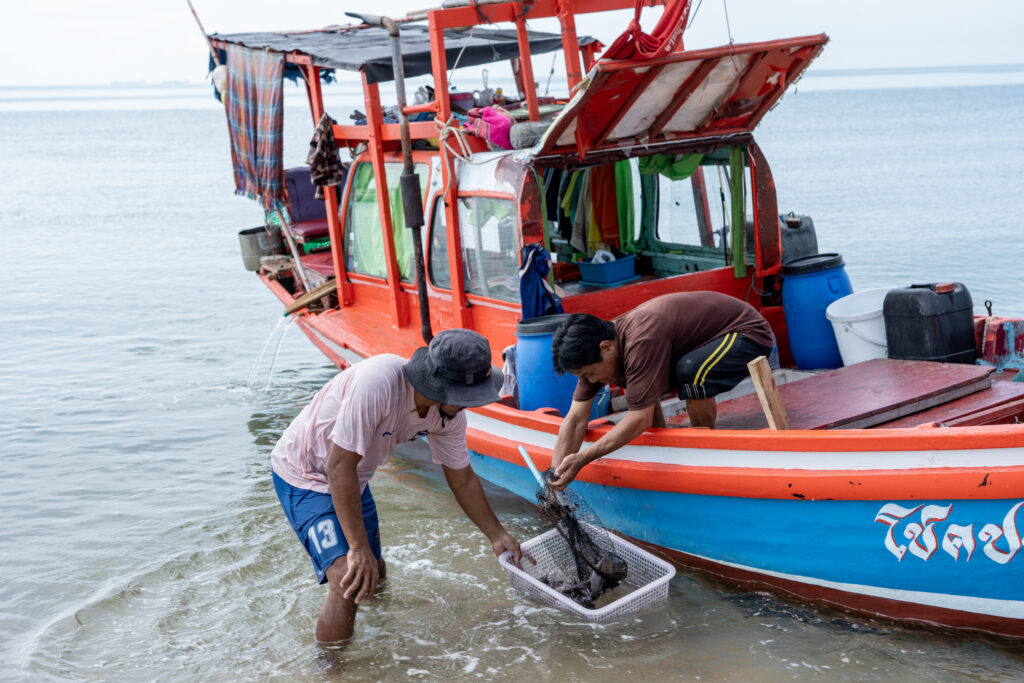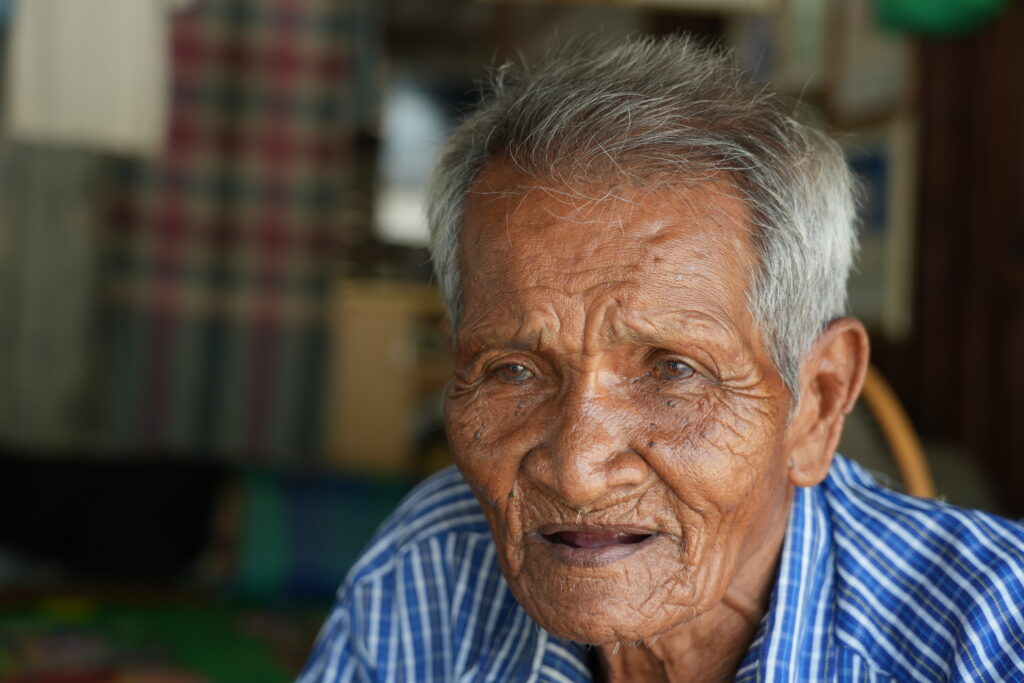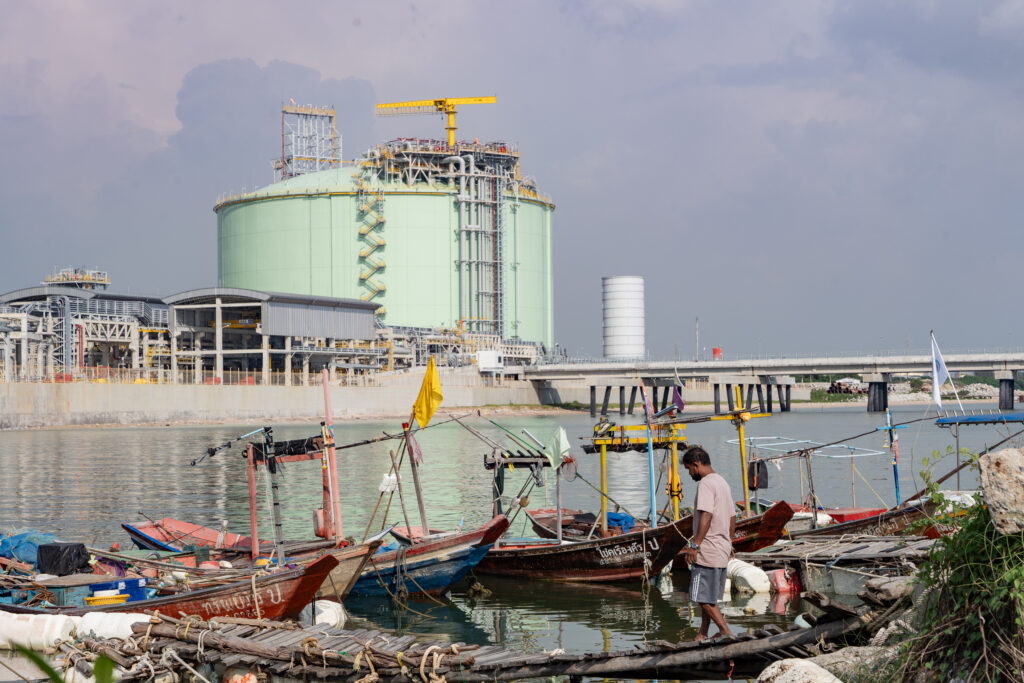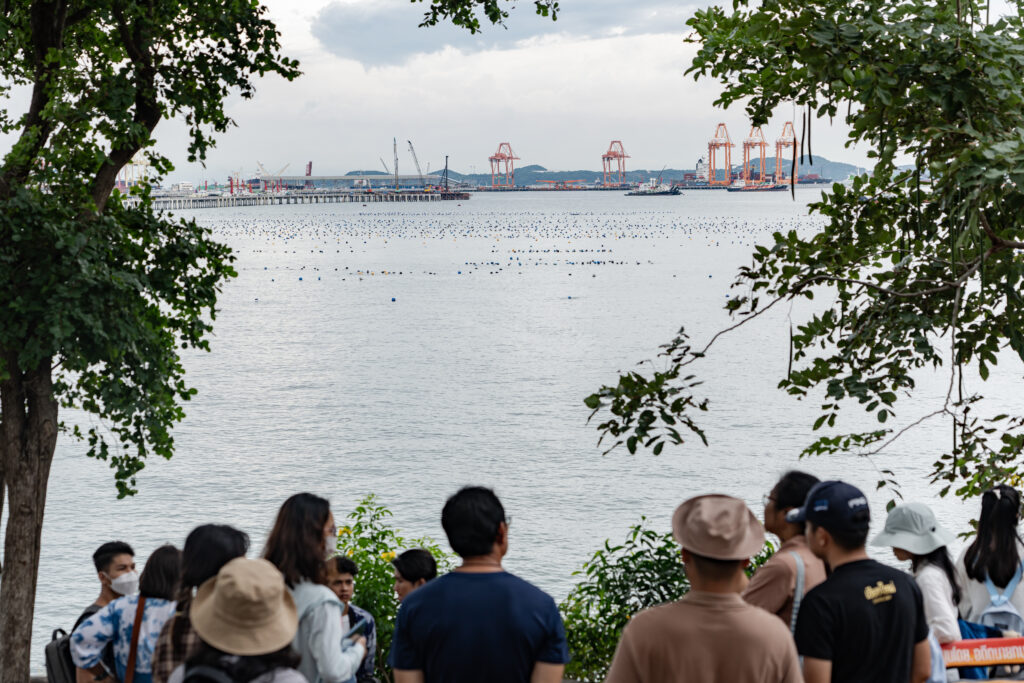This month, a group of staff and students from EarthRights School went on a week-long learning field visit to Map Ta Phut in Rayong and the nearby coastal communities along the Gulf of Thailand. The field visit aimed to educate students about earth rights issues and the impacts of mega-industrial estates on health and the environment.
Map Ta Phut once was a small rural farming and coastal fishing town. It now houses the Map Ta Phut Industrial Estate, which has grown to become the largest in Thailand, covering an area of 3,900 acres. The industrial estate is home to nearly 60 large factories, including petrochemical plants, oil refineries, coal-fired power stations, and steel companies.

Fishermen with their catch.
Map Ta Phut Industrial Estate was established in 1989 and has been promoted by investors as a model for mega-industrial estate projects for the past three decades. However, the industrial estate has faced widespread criticism due to the air pollution, water contamination, and hazardous waste it produces, and the fatal incidents that have resulted in injuries and loss of life. To this day, villagers and local community organizations continue to voice their opposition against the industrial estate and fight against it.
During our trip, we met with several villagers. We asked them about the impact of the industrial estate on human rights, the environment, health, and the socio-economic structures of their community.
Unlawful land acquisition
The issue of unlawful land acquisition has been a major problem for the villagers. According to the villagers, they were not fairly compensated when they were forced to move out of their lands during the establishment of the industrial estate. They also felt that the government agencies and investors did not adequately inform the communities about the land acquisition process.
Community leader Noi, now 83, recalled, “They did not announce what kind of law and policies they applied to take our land. There was no explanation and no negotiation. Other villagers disagreed with them and were forced to leave their land without compensation.”

83-year old community leader Noi.
Rural farming and coastal fishing communities face an increased risk of being affected by large-scale land acquisition for industrial estates, as their livelihoods depend on the land and sea. In theory, government agencies and investors are expected to obtain the informed consent of the local communities who live near the development project before proceeding. However, this fundamental right has been widely ignored in the Map Ta Phut Industrial Estate case.
The villagers did not get a chance to participate in the planning process for the Map Ta Phut Industrial Estate. They were not involved in calculating the compensation, and no complaint mechanism was available for them to voice objections even though the compensation was unfair.
“The authorities came. They just said they would take the land with a specific compensation. The amount could have been higher in the normal market. It was an unfair compensation. I don’t know in detail how they calculated it. I don’t know their process. They just called us to get money. I went there, signed the document, and took the money,” explained Noi.
The villagers regretted the loss of their land rights, which directly threatened their food security and livelihoods, leaving many landless and jobless.
Impacts of oil spill on the environment, livelihoods, and health
In addition to unlawful land acquisition, the villagers also face environmental issues, such as air pollution, water contamination, and hazardous waste produced by large factories in the industrial estate.
Incidents of oil spills occurred twice, once in 2013 and then again in 2022, and had devastating impacts on the environment and health of the local communities. Sea animals covered in oil can die due to poisoning or suffocation. Even if they survive, they will suffer for weeks or months after the incident as their food sources become more scarce and of lower quality.
Lamom, a community leader, expressed his concern about the negative impacts of the oil spills in Paknam Village, where he lives. “The two oil spills that happened and the use of chemical dispersants to clean the seawater resulted in the death of several sea animals. They hadn’t returned to the area where we usually fish,” he explained.

Lamom, a community leader, talking about the impact of oil spill.
The oil spills caused a disruption or temporary halt in fishing activities. In addition, the incidents resulted in much lower prices and market withdrawal of seafood caught by the villagers. Lamom lamented the loss of income, “The prices decreased because many people didn’t want to buy seafood. They were worried about contamination.”
Lamom further added that oil spills have dangerous effects on health. He said: “When the seawater quality is poor, it can cause rashes or skin diseases.”
Community raises voice against the mega-industrial estate
The affected villagers have sought various methods to voice their opposition against the Map Ta Phut Industrial Estate. They have formed campaign groups and organized protests against unlawful land acquisition and the harmful effects of the oil spill on their environment, livelihoods, and health.
Sawang, a community member who had worked in an industrial estate factory for many years, resigned when he realized the dangerous effects of the chemical substances used in the factory. He said: “I joined a network for people impacted by the industrial estate. I also participated in a protest march.”

Community member Sawang talking to EarthRights School students.
After the 2013 oil spill, the community members in Map Ta Phut and nearby coastal villages demanded that the oil company and government agencies be held accountable. A year later, lawsuits were filed against the oil company for damages and several government agencies for failing to handle the incident properly.
“The community needs help from academia because they can support the community in research activities. Moreover, the media is also a tool needed during campaigns to share the information openly with the public,” said Sawang.
Rapid industrialization continues in Map Ta Phut
The fishing and agricultural livelihoods of the local communities in Map Ta Phut and nearby coastal villages have significantly been impacted by the establishment of the industrial estate. It has led to unlawful land acquisition and socio-economic, environmental, and health problems in the area. Unfortunately, the communities have little power to negotiate with government agencies and influential industrial estate investors.
Today, Map Ta Phut is still facing severe pollution caused by large factories in the industrial estate. Rapid industrialization continues despite the local communities’ efforts to prevent further construction of new facilities in the industrial estate.
Map Ta Phut Industrial Estate is expanding to include new LNG terminals and liquid cargo berths before 2030.

Liquefied Natural Gas (LNG) close to a fishing community.
The EarthRights School
Thirteen human rights and environmental defenders from Cambodia, Laos, Myanmar, and Vietnam, including six women, participated in the EarthRights School this year. From July until November 2023, the students received intensive training from local and international experts. They also visited various communities, including Map Ta Phut, to witness the human rights and environmental issues on the ground. Upon completing their training at EarthRights School, many of these students will lead their communities in campaigns against human rights abuses and environmental exploitation.

EarthRights School students looking at the coast of Map Ta Phut Industrial Estate.
“I learned a lot from the field visit. I don’t have experience with big industrial zones, deep-sea ports, and factories. I feel a bit shocked hearing their big impacts and the sufferings of the local communities,” expressed one student from Myanmar.
Meanwhile, Sokchea, a student from Cambodia, shared that the field visit provided him with a deeper understanding of the impact of economic development on communities. “It highlights the importance of balancing industrial growth with environmental sustainability and the welfare of communities living near or around the development project,” he mentioned.
This blog is written with inputs from the research produced by EarthRights School students.





